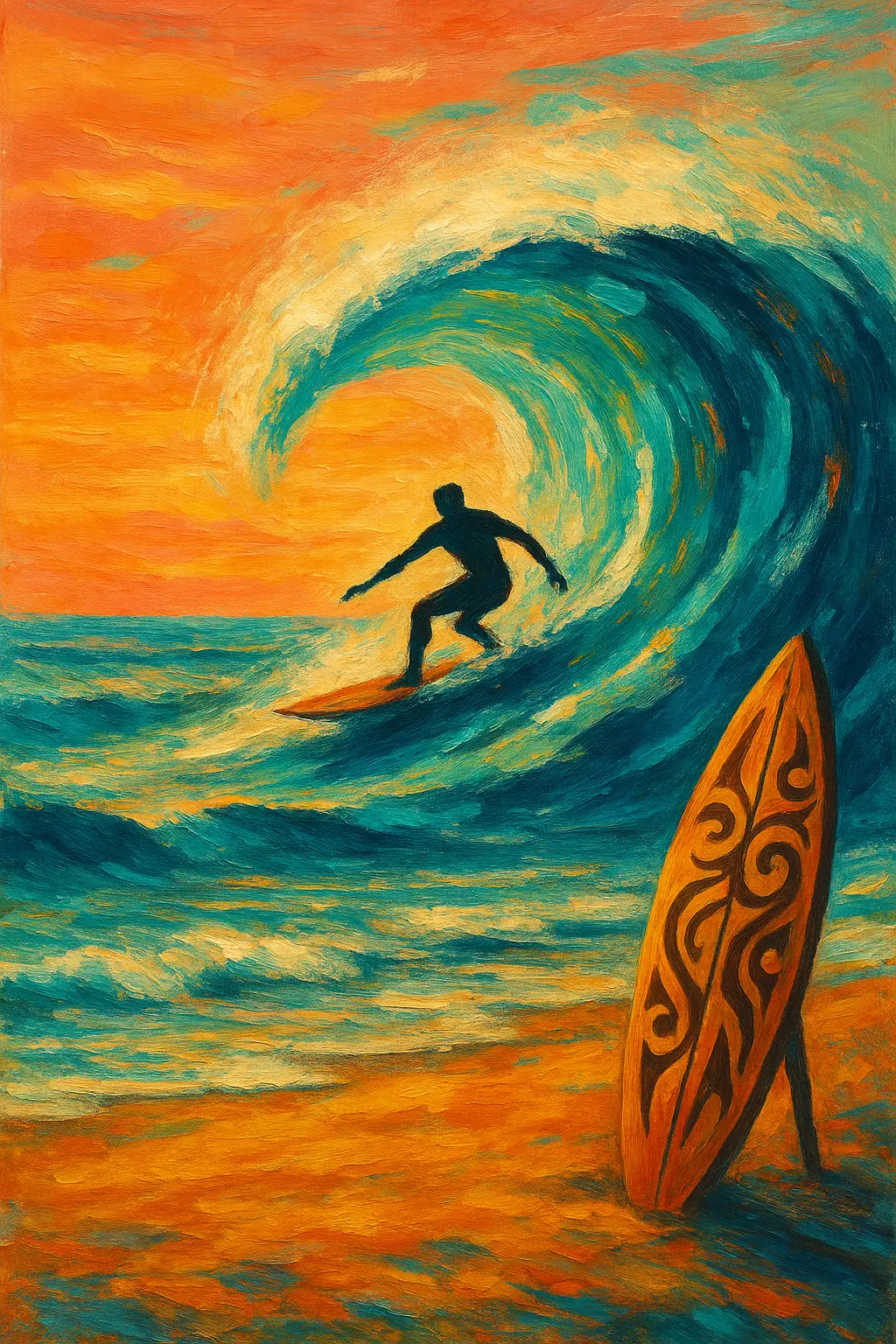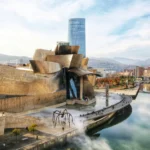Imagine this: you’re barefoot on the edge of the shore, board waxed, the scent of salt clinging to the breeze. The roar of the surf pulses in your chest, syncing with your heartbeat. You paddle out, meet a wave, and glide—momentum, freedom, stillness, all at once. That moment? That emotion? You can capture it—not just with a photo, but with paint, with brush strokes, with color and motion and soul.
That’s the power of surfing art.
It’s not just pictures of beaches or sketches of surfers. It’s a creative portal that draws you back into that liquid memory—sunlight on the water, wind in your face, and the deep, timeless rhythm of the ocean.
Whether you surf every day or haven’t touched a board in years, surfing art can reconnect you to that feeling. Through brush strokes, textures, and oceanic tones, you’ll find not only beauty—but an emotional language that speaks directly to the soul of the sea.

Table of Contents
What Is Surfing Art?
A Fusion of Surf Culture and Visual Expression
At its core, surfing art is a unique genre of visual storytelling. It captures the essence of surf culture, ocean rhythms, and coastal living through artistic expression. Unlike conventional landscapes or abstract pieces, surfing art places the ocean at center stage—not just as a setting, but as a character full of power and grace.
Surfing art includes:
- Paintings of crashing waves or surfboards in motion
- Sculptures shaped from driftwood, resin, or found coastal materials
- Photography frozen in time, often from the back of a breaking wave
- Mixed media and digital art, blending sea imagery with urban creativity
This genre isn’t bound by technique—it’s driven by energy. Every piece is an attempt to recreate the emotion of the ride, the calm before the wave, or the spiritual connection surfers feel with the ocean.
Key Characteristics of Surfing Art
What makes surfing art instantly recognizable? These features define the genre:
- Motion: Waves mid-crest, a surfer mid-turn, currents that curl and break
- Color Palettes: Deep ocean blues, seafoam greens, warm sands, coral pinks
- Themes: Freedom, wildness, serenity, and connection with nature
- Textures: Often layered or intentionally rough to mirror the tactile ocean world
This isn’t just decor—it’s a window into the salt-streaked soul of the surfing lifestyle.

The History of Surf-Inspired Art
From Polynesian Origins to Pop Culture Phenomenon
Before surfing became a modern sport, it was a sacred ritual. Ancient Polynesians carved designs into their wooden boards and surfed as part of spiritual ceremonies. Their surfboards weren’t just tools—they were cultural artifacts, passed down through generations.
Fast-forward to the 20th century: surfing exploded across the coasts of California and Hawaii. Alongside it grew a visual identity—surf posters, wave murals, surfboard designs, and lifestyle photography became iconic representations of this wave-riding life.
Notable eras include:
- The 1960s: Surf music, psychedelic posters, and surf magazines emerge
- The 1980s–1990s: Skate culture merges with surf aesthetics
- The 2000s onward: Surf art enters fine art galleries, NFTs, and design studios
Surf Art Legends Who Shaped the Genre
Some creators carved the wave into the art world:
- Drew Brophy: Famous for painting surfboards with wild, wave-charged designs
- Rick Griffin: Psychedelic poster artist and comic creator, rooted in surf lifestyle
- Heather Brown: Hawaiian painter with vibrant, approachable ocean scenes
- Thomas Campbell: A filmmaker and painter exploring surf through abstraction
Their work didn’t just decorate—it defined a cultural identity, blending counterculture and coastal vibes.
Modern Surfing Art Styles and Mediums
Common Mediums in Contemporary Surf Art
As an artist or collector, you’ll notice that surfing art isn’t limited to one canvas. Today’s artists experiment across a range of mediums:
- Acrylic Paintings: Bold, textured, and highly versatile
- Resin-Coated Surfboards: Functional art that rides or hangs on your wall
- Ocean Photography: Often shot inside the barrel or by drone
- Digital Artwork and NFTs: For those bringing waves into the metaverse
These mediums allow modern artists to amplify motion, light, and fluidity.
Popular Artistic Styles in Surfing Art
Whether you’re decorating or creating, you’ll find multiple aesthetics in this space:
- Realistic Wave Portraits: Highly detailed renderings of barrels and breaks
- Abstract Surf Art: Using form and flow to evoke emotional responses
- Pop Art Influences: Bright, graphic pieces reminiscent of vintage surf posters
- Minimalist Photography: Empty beaches, lone surfers, quiet mornings
Each style speaks differently—but all are tied by the thread of the ocean.
Table: Comparing Surfing Art Mediums
| Medium | Best For | Traits |
|---|---|---|
| Acrylic Painting | Wall decor, expressive pieces | Fast-drying, textured, vibrant |
| Surfboard Painting | Statement decor, custom boards | Resin-finished, UV-resistant |
| Photography | Capturing real-time surf motion | High-res, detailed, atmospheric |
| Digital Art/NFT | Modern collectors, global reach | Dynamic, animated, resellable |
Surfing Art in Coastal Home Decor
Why Surfing Art Transforms Your Space
When you bring surfing art into your home, you’re not just hanging a picture—you’re inviting the energy of the ocean into your life. Whether you live by the beach or in a city apartment, the right piece of wave-inspired art can:
- Evoke calm and relaxation after a stressful day
- Spark conversations and inspire creativity
- Serve as a visual reminder of your connection to nature
- Reflect your passion for surf culture and coastal living
You don’t need a surfboard leaning against the wall or shells on every shelf to embrace the beach aesthetic. Surfing art can do the heavy lifting with grace, style, and depth.
Smart Decorating Tips with Surfing Art
Here’s how you can make the most of surfing art in your home:
- Go Large with Canvas Waves: A single oversized wave painting or photograph can become the focal point of a living room or bedroom.
- Gallery Walls with Coastal Variety: Mix and match framed surf photography, ocean quotes, and abstract pieces for visual texture.
- Functional Art: Use hand-painted surfboards or skate decks as wall décor.
- Match the Vibe: Choose color schemes that complement your furniture—deep blues with cool grays, sandy tones with natural wood, or coral shades for a pop.
Best Rooms for Surfing Art
| Room | Recommended Style | Why It Works |
|---|---|---|
| Living Room | Large-scale wave canvas | Bold statement + relaxed atmosphere |
| Bedroom | Soft-toned ocean photography | Promotes rest, serenity |
| Bathroom | Sea-themed illustrations | Enhances spa-like feel |
| Office | Abstract or motivational surf art | Inspires focus and calm |
Creating Your Own Surf-Inspired Artwork
You Don’t Have to Be an Artist to Get Started
Creating surfing art isn’t reserved for professionals. If you’ve ever felt inspired by a wave, a sunset, or a surf session—you already have what it takes to make something meaningful.
Whether you’re looking to paint your own canvas or digitally design wave-inspired pieces, this section will walk you through the process.
How to Make Surfing Art (Step-by-Step)
- Find Your Muse
- Browse surf magazines, Pinterest boards, or your own beach photos.
- Look for unique wave shapes, silhouettes, or coastal moments that moved you.
- Choose Your Medium
- Are you comfortable with paints, markers, cameras, or digital tools?
- For beginners: Start with acrylics or watercolor on paper.
- Sketch the Energy, Not Just the Image
- Waves aren’t static. Think movement, direction, and rhythm.
- Use flowing lines, circular motion, and layered color.
- Stick to a Surf-Centric Palette
- Use blues, whites, sea greens, and sandy tones to evoke the ocean.
- Add Texture and Detail
- Incorporate splash patterns, sun reflections, or surfboard designs.
- Sign It. Frame It. Hang It.
- Your wall deserves a piece made by you, from the waves within you.
Color Palette Table: Coastal Tones for Surfing Art
| Color Name | Hex Code | Meaning in Art |
|---|---|---|
| Ocean Blue | #0077BE | Calm, stability, depth |
| Seafoam Green | #93E9BE | Peace, nature, clarity |
| Sandy Beige | #F5DEB3 | Warmth, nostalgia |
| Coral Sunset | #FF6F61 | Energy, emotion, vitality |
| White Foam | #F0F8FF | Purity, motion, highlights |
Use these tones together or as accents to balance intensity and softness in your surfing art.
Where to Find and Buy Surfing Art
Online, Local, and Custom Options
Whether you’re looking for a $20 print or a $2000 original, surfing art is more accessible than ever. Here’s where to start:
Online Marketplaces
- Etsy: Handmade surf art, prints, and surfboard paintings
- Saatchi Art: Museum-quality works and curated artist selections
- Society6 / Redbubble: Affordable surf-themed prints, pillows, and accessories
- OpenSea (for NFTs): Collect digital surf art from creators worldwide
Local Shops and Galleries
- Visit beachside galleries in surf towns like Santa Cruz, Byron Bay, or Bali
- Attend surf film festivals—many include art exhibits
- Check out local surf shacks or cafes that feature art walls
Custom Commissions
- Hire surf artists via Instagram, Fiverr, or their own portfolio sites
- Collaborate on a piece that captures your favorite wave, break, or trip
Table: Surfing Art Price Range Guide
| Type of Art | Typical Price Range |
|---|---|
| Surf Print Poster | $15–$50 |
| Hand-Painted Canvas | $200–$1500 |
| Custom Surfboard Design | $300–$1000 |
| Digital NFT Artwork | $100–$1000+ |
Pro Tip: Always verify if shipping and framing are included when buying online.
Surfing Art as a Reflection of Lifestyle
More Than Art—It’s a Way of Living
You may hang surfing art on your wall, but its influence runs deeper than decor. It becomes a daily reminder of your connection to something greater. Even when you’re away from the waves—stuck in traffic, working overtime, or enduring rainy days—surf-inspired creativity brings you back to your center.
Surfing art is:
- A portal to the coast
- A meditation on movement
- A philosophy wrapped in visuals
Whether you surf every morning or only dream of doing it, this genre reflects the deeper values of a surf-centered lifestyle—freedom, presence, passion, and a deep respect for nature.
Artist Insights and Inspirations
Here are words straight from the creators whose hands echo the surf:
- “Painting waves is like surfing with a brush.” – Drew Brophy
- “The ocean tells stories, and I try to paint the ones I hear.” – Heather Brown
- “Surfing art isn’t just what the sea looks like. It’s what it feels like when it owns you.” – Anonymous surfer-artist
By supporting surfing artists—or becoming one—you join a global creative movement grounded in ocean energy.
Conclusion:
There’s a rhythm to the waves that you can’t always explain—but you can express it.
That’s the essence of surfing art. It’s more than ink, canvas, or pixels—it’s memory, emotion, energy. When you bring surfing art into your life, you’re not just decorating a room—you’re grounding your space in movement and meaning.
FAQ : about Surfing Art
What exactly is surfing art?
Surfing art is visual artwork inspired by the ocean, wave patterns, surf culture, and coastal life. It ranges from painted surfboards and seascapes to abstract digital pieces and photography.
Is surfing art only for surfers?
Not at all. Anyone who feels connected to the ocean—or who simply loves coastal aesthetics—can enjoy, create, or collect surfing art.
Can surfing art be used in professional interior design?
Absolutely. Many interior designers use surf art to bring warmth and calm into spaces. It works well with coastal, boho, minimalist, or even industrial décor.
Where can I find affordable surfing art?
You can browse platforms like Etsy, Society6, Redbubble, or local surf shops. For custom or original pieces, try reaching out to emerging artists on Instagram.
How do I choose surfing art for my home?
Pick what feels right. Look for colors that calm or energize you, compositions that move your eyes, and pieces that reflect your personal connection to the sea.
Is it hard to make my own surfing art?
Not at all. Start with simple sketches or digital designs. Use the colors and emotions you feel at the beach. You don’t need to be a professional artist—just someone who feels the wave.








Leave a Reply